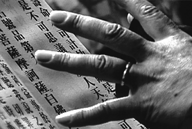Nail
 TAIWAN / 2002 / No dialogue / B&W / 35mm (1:1.33) / 45 min
TAIWAN / 2002 / No dialogue / B&W / 35mm (1:1.33) / 45 min
Director, Photography: Huang Ting-fu
Editing: Zhang Shuwa
Sound: Chao Yuan-fon
Music: Dino Liao
Producer, Source: Chen Liyu
100 F4, No. 7 Ching-Tao East Rd. Taipei TAIWAN
Phone: 886-2-23924243
Fax: 886-2-23068280
E-mail: liyu8888@ms23.hinet.net
Long-Shan Temple stands in the center of crowded Taipei. Diverse people gather in the temple precincts: a middle-aged woman intently throwing fortune-telling tablets, an elderly man sitting down to take a nap, beggars, flower sellers, and tourists who keep their cameras ready. By layering a year’s worth of impressive black-and-white snapshots, this film uses a uniquely experimental method to capture the coexistence of seediness and serene silence. The original title is taken from the name of a sutra, which is said to refer to the concept of tacit understanding, something often used by Zen masters. The two characters in the title represent “finger” and “moon,” and might also remind us of the shape of fortune-telling tablets or the crescent shape at the base of our fingernails.
[Director’s Statement] In early 2001 I revisited Long-Shan Temple, a historical temple located in a dark and chaotic neighborhood. Emerging from the modern and clean subway, you see scores of fortune-tellers and food vendors, middle-aged prostitutes and antique vendors along Kong-Ding Road. This is a playground for proletariats, full of cheap but delicious food and spaces where you find only simple and basic human desires—for a bite of rice, a drag on a cigarette, a bottle of wine, or some sex. In the temple, elderly people sit quietly in the corner, sleeping, murmuring, or leaving their minds blank. One by one, they look like statues carved from time, moving to the conclusions of their lives. I am touched by all these images, desiring to record them in detail. Their way of facing time is something I am not able to achieve. I feel anxious, disturbed, and unable to “do nothing.” Let’s either forget time, or squander it away in a limited space!
This film begins on February 24, 2001. The small and crowded temple is not beautiful or famous. Why do people take refuge here, make daily visits, do nothing and then return home? What is the charm of the temple for these people? And what can I shoot in my film? I confined myself to a space of about 200 square meters in the temple, and spent one year shooting the film and another half-year editing.
Watching the completed film again, I was suddenly touched by how people feel so unsafe and anxious. Is it specific to the unique situation in contemporary Taiwan? My original intention was to record the common destiny of human beings, beyond Taiwan’s unique status. But, perhaps this anxious and unsafe feeling can only be found in a special situation in a special country, while we ourselves are unaware of it?
 Huang Ting-fu
Huang Ting-fu
Born in 1961. Graduated from the National Taiwan College of Arts. Presently works at the Chinese Taipei Film Archive. In 1989, won a Golden Harvest Award for The Mirror. Other films include The May 15th Archive (1988), Bowl (1990), Wedding Portrait (1992), Modeling Taiwan (2000), and 03:04 (2000), screened at YIDFF 2001. |
|
• New Asian Currents | Sand and Water | Wellspring | Three-Five People | Homesick | The Circle’s Corner | The Maze of Lanes | Nee Engey—Where Are You | NEW (IMPROVED) DELHI—Director’s Cut | A Night of Prophecy | 150 Seconds Ago | The Ballad of Life | Noah’s Ark | The Old Man of Hara | Dandelion | Hibakusha—At the End of the World | 3rd Vol.2—2 Light House | And Thereafter | Dust Buries Sabuk | Family Project: House of a Father | Edit | Gina Kim’s Video Diary | Ordo | Her and Him Van Leo | The Big Durian | Perpetual Motion | Debris | Hard Good Life | Nail | The Rhythm in Wulu Village | A Short Journey • Jurors | Kim Dong-won | Kawase Naomi • New Asian Currents Special | Part 1 | Part 2 |
